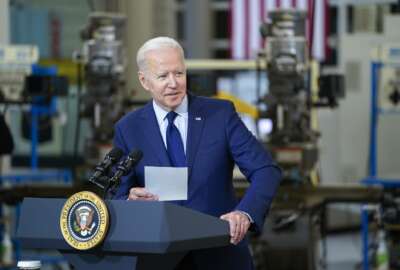Exclusive
Locality tweaks are only the tip of the federal pay iceberg, managers coalition warns
Creating new locality pay areas while larger federal pay problems loom is “akin to rearranging deck chairs on the Titanic,” the Senior Executives Association...
Nearly 33,000 federal employees are almost set to receive a little more in their paychecks starting in 2024, thanks to new proposed rules from the Office of Personnel Management to establish four new locality pay areas.
Many federal unions and organizations have lauded OPM’s proposal, but at the same time, federal manager advocacy groups said these relatively small tweaks to locality pay are only the tip of the iceberg.
“Creating new locality pay zones when systemic compensation issues holistically undermine the government’s competitive posture is akin to rearranging deck chairs on the Titanic,” Senior Executives Association President Marcus Hill said in a July 7 letter to the President’s Pay Agent. “It is not enough.”
The Federal Salary Council and the President’s Pay Agent, two bodies tasked with determining the structure of the federal pay system, are not doing enough to address systemic compensation challenges for the federal workforce, said the SEA and Professional Managers Association. The two organizations wrote letters, obtained by Federal News Network, to top leaders at the Labor Department, Office of Personnel Management and Office of Management and Budget — the three agencies that comprise the President’s Pay Agent — to express urgent concerns over a long-flawed system for federal pay.
The two groups are now calling on the Biden administration to propose a specific way to fix to pay compression for federal employees. For years, SEA and PMA have been vocal over the issue of pay compression on the General Schedule, a phenomenon that affects some GS-15s, depending on where they work and their spot on the federal career ladder. Salaries for career employees on the General Schedule can’t exceed pay rates for political appointees and others at level IV on the Executive Schedule, according to federal statute. Even though Congress or the president raise federal employee salaries each year, a pay cap has remained in place for those on the Executive Schedule — and therefore also remains for federal managers situated in the upper levels of the General Schedule.
“Pay compression skews the risk-reward trade-off for employees advancing in their federal careers,” SEA’s Hill said in the letter. “At a certain point, the risks of advancing in management continue to grow, but the rewards do not keep pace.”
“The Federal Salary Council has failed to offer recommendations addressing the critical issue of pay compression and the devastating effects it has both for individual employees affected by compression and pay caps as well as for agencies competing for in-demand talent,” PMA Executive Director Chad Hooper said in another letter to the pay agent. He additionally urged the pay agent to conduct a study on the effects of pay compression, and if it makes feds more likely to leave their jobs.
“Looking at attrition, retention, promotion and other key human capital indicators, the government must know if employees affected by pay compression are acting similar or different as their peers who have not hit the cap,” Hooper said.
And it’s not just pay compression. The President’s Pay Agent, for years, has said in annual reports to the president that “major legislative reforms” are needed to address issues with federal pay overall. For more than a decade, federal pay raises have trailed raises of those in the private sector, according to data from the Bureau of Labor Statistics. But for Jason Briefel, SEA’s director of policy and outreach, simply writing that there is a need for reform is not enough.
“I’ve read 20 years of those reports — you get to a certain point where it doesn’t even matter if it’s a Democrat or a Republican in the White House. They both are saying that the system doesn’t work, it’s leaving certain employees behind and it needs to be revisited,” Briefel said in an interview with Federal News Network. “And yet, we seem like we’re in this never-ending carousel ride, where somebody is just pointing to the person to the left of them, but nobody ever does the hard work and comes up with a proposal.”
Further adding to the rhetoric, the Biden administration earlier this calendar year hinted at a goal of fixing pay compression in the fiscal 2024 budget request. So far, there is no specific plan publicly available from the administration to address pay compression. In another letter last week, leaders in the Government Managers Coalition (GMC) said they “eagerly await” the promised proposal from the Biden administration.
“It is our understanding that OPM has considered options for solving key pay issues such as pay compression but has not yet drafted legislation,” the GMC leaders said in the July 5 letter, addressed to OPM Director Kiran Ahuja. “We cannot emphasize enough how dire the situation is becoming at agencies … The government cannot function without managers and leaders, yet the current pay structure disincentives employees from entering leadership at every point.”
The GMC letter comes just ahead of a Senate Appropriations Committee hearing scheduled for Thursday which may speak to the federal employee pay raise. The committee is scheduled to consider the fiscal 2024 Financial Services and General Government appropriations bill during the hearing.
The coalition’s leaders warned that pay issues across the country will only worsen unless the administration proposes reforms that rationalize the federal government’s various pay systems and address pay compression.
“Through these alternate pay systems, Congress and OPM try to enhance government’s ability to compete with industry in select job categories,” Hill said. “But the problem does not only exist within discrete job categories, but across the entire General Schedule.”
Still, SEA and PMA emphasized that they do support the locality pay changes that OPM proposed earlier this month. They’re a significant improvement, the leaders said, but only address one aspect of a much broader problem.
“You can see a trend from administration to administration, year to year,” Briefel said. “They’re like, ‘Man, this pay system is crazy. Man, this thing doesn’t work. Somebody really needs to propose a better system here.’ But, you know, OPM is part of the pay agent, OMB is part of the pay agent, the secretary of Labor is part of the pay agent. Who are these folks waiting on to come up with a plan?”
Copyright © 2025 Federal News Network. All rights reserved. This website is not intended for users located within the European Economic Area.
Drew Friedman is a workforce, pay and benefits reporter for Federal News Network.
Follow @dfriedmanWFED






